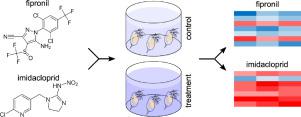Aquatic Toxicology ( IF 4.5 ) Pub Date : 2021-07-27 , DOI: 10.1016/j.aquatox.2021.105927 Julia Pfaff 1 , Hannes Reinwald 2 , Steve U Ayobahan 3 , Julia Alvincz 3 , Bernd Göckener 4 , Orr Shomroni 5 , Gabriela Salinas 5 , Rolf-Alexander Düring 6 , Christoph Schäfers 7 , Sebastian Eilebrecht 3

|
Active substances of pesticides, biocides or pharmaceuticals can induce adverse side effects in the aquatic ecosystem, necessitating environmental hazard and risk assessment prior to substance registration. The freshwater crustacean Daphnia magna is a model organism for acute and chronic toxicity assessment representing aquatic invertebrates. However, standardized tests involving daphnia are restricted to the endpoints immobility and reproduction and thus provide only limited insights into the underlying modes-of-action. Here, we applied transcriptome profiling to a modified D. magna Acute Immobilization test to analyze and compare gene expression profiles induced by the GABA-gated chloride channel blocker fipronil and the nicotinic acetylcholine receptor (nAChR) agonist imidacloprid. Daphnids were expose to two low effect concentrations of each substance followed by RNA sequencing and functional classification of affected gene ontologies and pathways. For both insecticides, we observed a concentration-dependent increase in the number of differentially expressed genes, whose expression changes were highly significantly positively correlated when comparing both test concentrations. These gene expression fingerprints showed virtually no overlap between the test substances and they related well to previous data of diazepam and carbaryl, two substances targeting similar molecular key events. While, based on our results, fipronil predominantly interfered with molecular functions involved in ATPase-coupled transmembrane transport and transcription regulation, imidacloprid primarily affected oxidase and oxidoreductase activity. These findings provide evidence that systems biology approaches can be utilized to identify and differentiate modes-of-action of chemical stressors in D. magna as an invertebrate aquatic non-target organism. The mechanistic knowledge extracted from such data will in future contribute to the development of Adverse Outcome Pathways (AOPs) for read-across and prediction of population effects.
中文翻译:

大型水蚤对氟虫腈和吡虫啉功能反应的毒理学差异
杀虫剂、杀菌剂或药物的活性物质会在水生生态系统中引起不良副作用,需要在物质注册前进行环境危害和风险评估。淡水甲壳类Daphnia magna是代表水生无脊椎动物的急性和慢性毒性评估的模式生物。然而,涉及水蚤的标准化测试仅限于终点不动和繁殖,因此只能提供对潜在作用模式的有限洞察。在这里,我们将转录组分析应用于改良的 D. magna 急性固定化测试,以分析和比较由 GABA 门控氯通道阻滞剂氟虫腈和烟碱乙酰胆碱受体 (nAChR) 激动剂吡虫啉诱导的基因表达谱。将水蚤暴露于每种物质的两种低效应浓度下,然后进行 RNA 测序和受影响基因本体和途径的功能分类。对于这两种杀虫剂,我们观察到差异表达基因的数量呈浓度依赖性增加,当比较两个测试浓度时,其表达变化高度显着正相关。这些基因表达指纹显示测试物质之间几乎没有重叠,并且它们与先前的地西泮和甲萘威数据相关,这两种物质针对相似的分子关键事件。虽然,根据我们的结果,氟虫腈主要干扰参与 ATP 酶偶联跨膜转运和转录调控的分子功能,吡虫啉主要影响氧化酶和氧化还原酶活性。这些发现提供了证据,表明系统生物学方法可用于识别和区分化学应激源的作用模式 这些基因表达指纹显示测试物质之间几乎没有重叠,并且它们与先前的地西泮和甲萘威数据相关,这两种物质针对相似的分子关键事件。虽然,根据我们的结果,氟虫腈主要干扰参与 ATP 酶偶联跨膜转运和转录调控的分子功能,吡虫啉主要影响氧化酶和氧化还原酶活性。这些发现提供了证据,表明系统生物学方法可用于识别和区分化学应激源的作用模式 这些基因表达指纹显示测试物质之间几乎没有重叠,并且它们与先前的地西泮和甲萘威数据相关,这两种物质针对相似的分子关键事件。虽然,根据我们的结果,氟虫腈主要干扰参与 ATP 酶偶联跨膜转运和转录调控的分子功能,吡虫啉主要影响氧化酶和氧化还原酶活性。这些发现提供了证据,表明系统生物学方法可用于识别和区分化学应激源的作用模式 氟虫腈主要干扰参与 ATP 酶偶联跨膜转运和转录调控的分子功能,吡虫啉主要影响氧化酶和氧化还原酶活性。这些发现提供了证据,表明系统生物学方法可用于识别和区分化学应激源的作用模式 氟虫腈主要干扰参与 ATP 酶偶联跨膜转运和转录调控的分子功能,吡虫啉主要影响氧化酶和氧化还原酶活性。这些发现提供了证据,表明系统生物学方法可用于识别和区分化学应激源的作用模式D. magna作为无脊椎动物水生非目标生物。从这些数据中提取的机械知识将在未来有助于不良结果途径 (AOP) 的发展,用于人口影响的交叉阅读和预测。


























 京公网安备 11010802027423号
京公网安备 11010802027423号